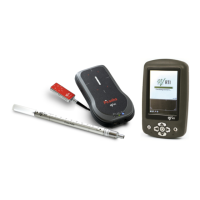5. Measurements with the Piranha System
Radiography
2014-06/5.5C
89
Piranha & QABrowser Reference Manual
Radiography5.2
This topic will describe how to measure kVp, dose, and
exposure time on a radiographic unit using the Piranha.
Set up the Piranha and the handheld computer according to
the description in Setting Up the Piranha .
Measuring the kVp on a radiographic units is straightforward since the Piranha can
automatically detect and compensate for variation in the radiation quality. It is also easy
to check that the detector area is fully and uniformly irradiated. Practically this means
that the kVp value can be measured in the range 1.0 to 50 mm of total filtration.
Therefore the Piranha can be placed in the beam
wherever you want, as long as it passes the Position
Check. It also has a very wide dynamic range so it
very rarely happens that the signal level is not
enough to get a correct kVp value. The radiography
kV range is 35 to 155 kV.
You can either select the tube voltage as single parameter or together with dose, dose
rate, and exposure time. As complementary information estimations of the total filtration
and type of waveform are made. This feature uses the kV filter R1[4] (55 - 105 kV). This
is the default kV range for radiography when the Piranha is turned on.
The displayed dose value has no energy dependence since it is automatically
compensated for each exposure since both the kV, estimated filtration, and the
waveform are measured. Even without compensating the dose value, the energy
dependence is small in the radiography range. This is also true for the kVp value. A
10 mm Al change of the beam filtration at 70 kV increases the kV only about 3.5 kV
without automatic compensation. With compensation the change in kVp is less than
0.3 kV.
12

